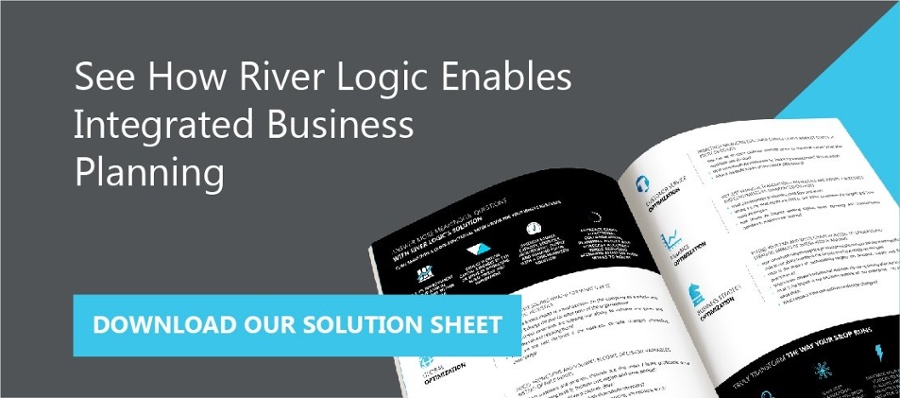However, more than 60 percent of companies say their leading planning tool doesn’t support this collaborative planning process.
So, what are companies missing by not utilizing IBP? See how the experts describe IBP’s potential impact—and why it’s increasingly vital for businesses:
- Better company positioning: An IBP approach brings with it the potential for greater agility and improved control across your business. It also can enhance communication throughout the enterprise, improve your ability to manage by exception, and position your organization to take advantage of new market trends. — Deloitte
- Breaking with tradition: IBP fosters collaborative decision-making, breaking traditional divisions between business intelligence, corporate performance management and predictive analytics. — CFO
- In support of one IBP platform: Some argue that mature IBP processes can be supported by separate EPM and S&OP applications. Such assertions are incorrect. What’s not being recognized is that meaningful integration is only achieved when planning applications share the same models. When they don’t, capability gaps arise. — Dean Sorensen, IBP Collaborative
- Using the same technology provider: Software from the same technology provider will be easier to implement. Integration will be easier. This is a commonly-held belief. The sad thing is that it is not true. For example, the recently introduced solution SAP Integrated Business Planning (IBP) is tougher to integrate to SAP ERP than alternatives. Yet, because the same suite is sold by SAP, there is a belief that integration will be easier. — Lora Cecere, President of Supply Chain Insights
- Insight into customer demand: An integrated business planning solution provides your company with insight into customer demand. Imagine you’re an automotive manufacturer. With demand sensing capabilities, you can accurately determine how many cars you’ll need to build throughout the year. And you’ll know precisely how much aluminum you require to do it. — Hala Zeine, President of Digital Supply Chain
- Regarding profit: The core supply chain process, integrated business planning, seeks to profitably balance demand and supply. — Steve Banker, analyst
- On flexibility: Integrated business planning processes [...] must be responsive and flexible to changes in supply, demand, and other signals across the supply chain. These improved processes enable companies to better manage collaboration across partner networks and more efficiently handle everything from a shipment of one item to multiple truckloads headed across borders. — Richard Howells, Brand Contributor, Forbes
- Supporting corporate sustainability: To remain important long-term, they [corporate social responsibility and enterprise sustainability planning solutions] must become an integral part of an IBP process, because only then will limited resources be allocated in the most optimal, fiscally-responsible manner while still meeting all important corporate sustainability goals. — Eric Kelso, VP of product management, River Logic
- More than the supply chain: IBP is not just about the supply-chain; it’s about the business. — Nari Viswanathan
- The key component: IBP supports demand, supply and financial planning simultaneously, respecting the firm’s market, policy, supply and financial constraints and leveraging optimization to help users identify insights not visible through sequential planning approaches as are commonly deployed in S&OP. — Carlos Centurion, President of River Logic
- Aligns the business: Digital businesses can use integrated business planning (IBP) to align strategic, operational, and financial plans to improve business performance, drive superior customer service from the same fixed and working capital, and clarify the full impact of decisions about operations. — Forrester
- Regarding integration: It can be argued that current IBP development is still driven by a supply chain bias. With this lack of diverse thinking, IBP innovation runs the risk of being not truly ‘integrated’. — Niels Van Hove, Supply Chain Consultant
- What “successful” means: Visualize aligning your company’s operational decisions with forward-looking financial performance across various timeframes, representing complex trade-offs, constraints, and real-time business realities across the value chain; this is what a successful IBP looks like! — Shannon Kearns, Director of Marketing, River Logic
- The value of partners: Change management challenges are an inherent part of any IBP project and will become a recurring theme as companies move from silo-based systems and departmental objectives. Fortunately, many of the world’s most trusted management consulting/strategic advisory firms are quickly moving to establish advanced analytics service lines designed specifically to meet both the technical and change management challenges ahead. — Kevin Howe, Board Chairman and CEO of River Logic
- Managing pricing: With fluctuating cost inputs, varying promotional campaigns, product portfolios with widely different prices, and shifting constraints in the supply chain, integrating financials with S&OP is needed more than ever. — Stephen Crane, S&OP/IBP consultant
- On margins: Integrated business planning solutions from our partners like River Logic evaluate marginal profit and hence can prioritize low-volume, high margin niche products over high-volume, lower margin mainstream products to ensure optimal demand-capacity matching and allocation in case of capacity shortages. — Ashutosh Bansal, Founder and CEO of GitaCloud
- Financial performance: Integrated business planning (IBP) is a model that enables greater planning accuracy and operational performance by aligning strategic planning, finance, supply chain, sales, marketing, and product development functions. It is this alignment that drives real corporate performance like earnings per share, operating margin, and working capital. — KPMG
- Selecting an IBP solution: IBP integrates strategic and financial planning on top of a foundational layer of operational and tactical planning to drive closed-loop performance. It is a collaborative decision-making process that balances functional goals and constraints and defines joint actions to achieve the overall business plan. — The Hackett Group
- Real-time results: Integrated business planning lets companies conduct scenario planning with rapid, practically real-time simulation. Through this capability, companies can analyze risks and opportunities to make educated supply-demand decisions when the unexpected happens. — Can A. Dogan, principal, Ernst & Young
- Five key traits outlined in a recent EY white paper:
- Grounded in organization’s purpose
- Integrated with the business management cycle
- Focuses on a set of a few critical metrics that can be used to measure progress towards strategy
- Links strategy with critical business performance levers in a logical framework to “drive” outcomes
- Builds on or refines existing strategic initiatives where feasible, rather than establishing new, overlapping or competing projects
- Why IBP? Companies are turning to IBP to ultimately ensure that profitability is at the center of operational planning. Companies conceptually know all sales are not created equal. However operationally, planning processes simply consider a unit as a unit, with little consideration of the attached economics. — Sebastian Valencia, Consultant
Whether your company wants to move beyond the standard S&OP process or is seeking a platform to manage corporate sustainability practices that align with the business as a whole, integrated business planning is the future.








